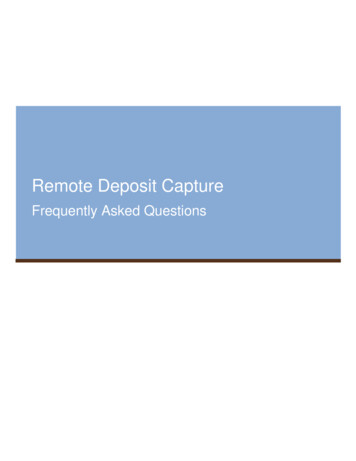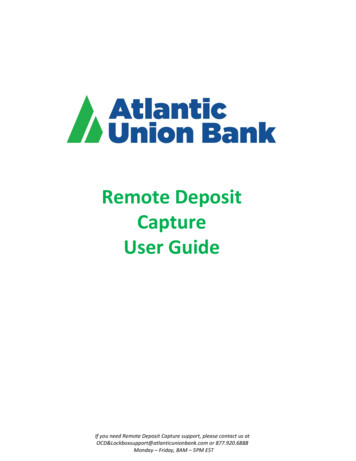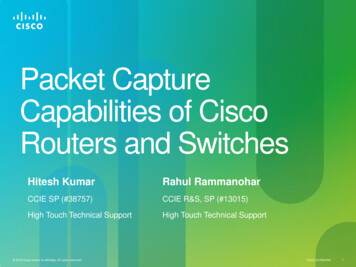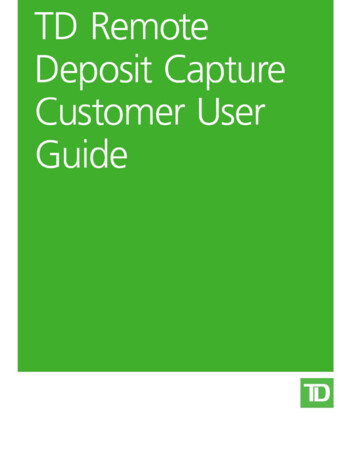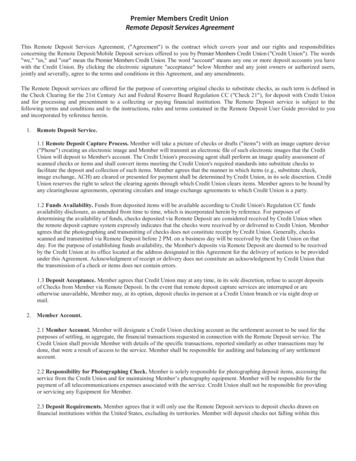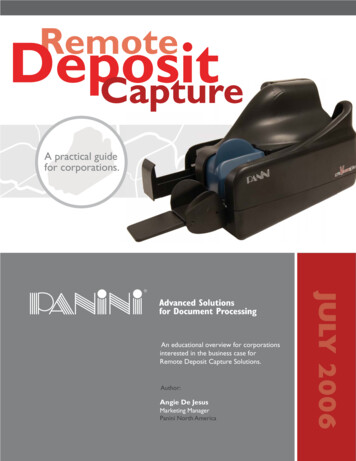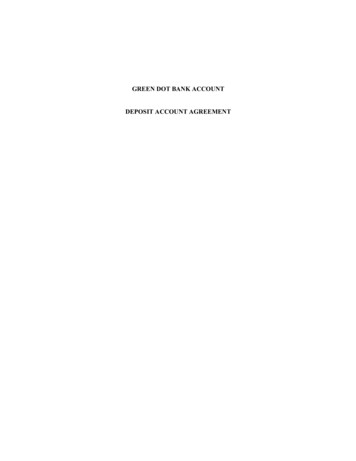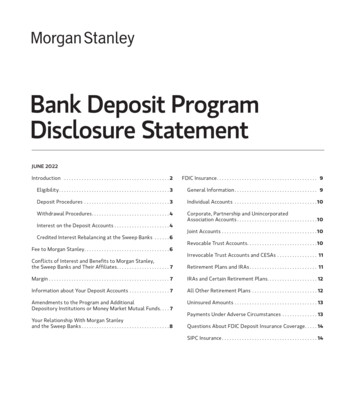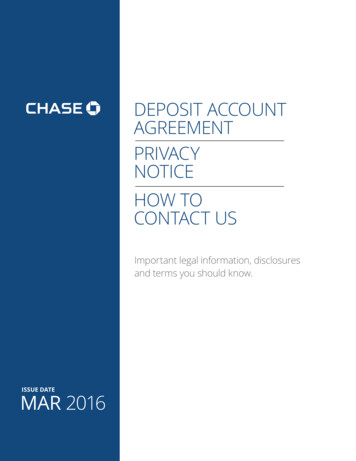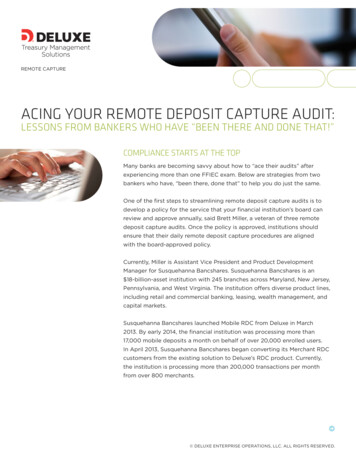
Transcription
REMOTE CAPTUREACING YOUR REMOTE DEPOSIT CAPTURE AUDIT:LESSONS FROM BANKERS WHO HAVE “BEEN THERE AND DONE THAT!”COMPLIANCE STARTS AT THE TOPMany banks are becoming savvy about how to “ace their audits” afterexperiencing more than one FFIEC exam. Below are strategies from twobankers who have, “been there, done that” to help you do just the same.One of the first steps to streamlining remote deposit capture audits is todevelop a policy for the service that your financial institution’s board canreview and approve annually, said Brett Miller, a veteran of three remotedeposit capture audits. Once the policy is approved, institutions shouldensure that their daily remote deposit capture procedures are alignedwith the board-approved policy.Currently, Miller is Assistant Vice President and Product DevelopmentManager for Susquehanna Bancshares. Susquehanna Bancshares is an 18-billion-asset institution with 245 branches across Maryland, New Jersey,Pennsylvania, and West Virginia. The institution offers diverse product lines,including retail and commercial banking, leasing, wealth management, andcapital markets.Susquehanna Bancshares launched Mobile RDC from Deluxe in March2013. By early 2014, the financial institution was processing more than17,000 mobile deposits a month on behalf of over 20,000 enrolled users.In April 2013, Susquehanna Bancshares began converting its Merchant RDCcustomers from the existing solution to Deluxe’s RDC product. Currently,the institution is processing more than 200,000 transactions per monthfrom over 800 merchants. DELUXE ENTERPRISE OPERATIONS, LLC. ALL RIGHTS RESERVED.
2REMOTE CAPTUREMiller’s first RDC audit was with First National Bank of Chester County(FNBCC) in 2009. FNBCC was a 1.1-billion-asset financial institutionwith 25 banking offices that was acquired by Tower Bancorp. About 100merchants used FNBCC’s RDC service.“If you say yourbank is doingsomething, makesure the bank isdoing it.”Brett Miller,Assistant Vice PresidentandProduct DevelopmentManager, SusquehannaBancsharesDuring FNBCC’s remote deposit capture audit,Miller learned several valuable lessons: The importance of a formal RDC risk assessment program The importance of formal RDC policies and procedures The need to include customer responsibilities, including the customer’srole in security and document retention requirements, in the institution’sremote deposit capture agreement The need to include remote deposit capture in the institution’s businesscontinuity plan“When the bank initially rolled-out remote deposit capture, we didn’t havedocumented procedures or a board-approved policy for the service, ourcustomer agreement was only about two pages, and remote deposit capturewas not part of the bank’s business continuity plan,” Miller explained.In addition to addressing these issues, FNBCC also implemented depositlimits for monitoring merchant deposits and an annual review process forremote deposit capture customers.Miller’s second remote deposit capture audit was with Tower Bancorp in 2011.Tower Bancorp was a 2.7-billion-asset financial institution that was acquiredby Susquehanna Bancshares in 2012. About 300 merchants used TowerBancorp’s remote deposit capture service at the time of the audit. DELUXE ENTERPRISE OPERATIONS, LLC. ALL RIGHTS RESERVED.
3REMOTE CAPTURE“The federal reserveexaminers wantedto know how thebank ensures thatthe responses toour risk assessmentform are actuallyprovided by thecustomer, and arenot ‘made up’ byour team. Theexaminers alsowanted tounderstand whetherwe train customerson how to transmitdeposits, our duplicatedetection procedures,and out methodologyfor establishingrisk monitoringbusiness rules.”Brett Miller,Assistant Vice PresidentandProduct DevelopmentManager, SusquehannaBancsharesMiller learned several lessons from the remote depositcapture audit at Tower Bancorp, including: The importance of a strong focus on monitoring customer remotedeposit capture activity, specifically, identifying anomalies and/orsuspicious patterns in merchant deposits The necessity of a comprehensive merchant capture policy withannual board approval The importance of updating the financial institution’s remote depositcapture risk assessment plan to encompass a larger market area andcustomer base as a result of a bank acquisition“The chief takeaway from the audit was to focus on risk assessment. TowerBancorp was a small bank that grew quickly and didn’t have a lot of writtenprocedures. The bank completed two acquisitions since its previous remotedeposit capture audit was conducted, and, as a result, it was moving intolarger metropolitan areas. We were asked to more closely monitor merchantactivity, such as large spikes in customer deposit volumes,” Miller said.In 2013, Susquehanna Bancshares completed both internal and FederalReserve audits of its remote deposit capture procedures and policies.The bank conducts an internal remote deposit capture audit every 2 years.“Our most recent internal audit focused on procedures for temporarydeposit limits and how they integrate with the bank’s credit policy. Ourauditors wanted to understand the process for handling over-limit situations,”he said.Susquehanna Bancshare’s internal audit also focused on: Scanner inventory: accounting for all of the scanners used by itsremote deposit capture customers, and ensuring that the bank isproperly billing clients to use the scanners System access: ensuring that only employees with relevant jobduties can access the system Third-party checks: Ensuring that the payee name on thecheck matches the account name DELUXE ENTERPRISE OPERATIONS, LLC. ALL RIGHTS RESERVED.
4REMOTE CAPTUREMiller said the federal reserve audit largely focused on: Customer due diligence: education during customer on-boarding andduring the annual customer review, and physical and logical securitycontrols at customer locations dherence with board-approved policies and procedures: documentingAthe daily activities to ensure compliance with the bank’s board-approvedremote deposit capture policy: “If you say in policy your bank is doingsomething, make sure the bank is doing it,” he said. Duplicate item detection: enterprise-wide duplicate item detectionacross all of the bank’s remote deposit capture channels (branch, mobile,merchant, automated teller machine) Risk monitoring: processes and procedures to identify potentialdeposit risks“The Federal Reserve examiners wanted know how the bank ensures that theresponses to our risk assessment form are accurately outlining the customerscontrol environment” he said. “The examiners also wanted to understandwhether we train customers on how to transmit deposits, our duplicatedetection procedures, and our methodology for establishing risk monitoringbusiness rules.”Miller said he has learned several valuable lessons from his audits. The firstlesson is for financial institutions to diligently document and adhere toprocedures for daily remote deposit capture activities, client on-boarding,over-limit approval, credit downgrades, and customer termination. Financialinstitutions should also develop a customer qualification and due diligenceprocess for initial customer on-boarding and annual account reviews. Finally,he recommended that institutions conduct an annual risk assessment andfinancially quantify and document all potential risks. DELUXE ENTERPRISE OPERATIONS, LLC. ALL RIGHTS RESERVED.
5REMOTE CAPTUREKNOW YOUR CUSTOMERThere’s no better way to assess the risks of an RDC user than to visitthem in-person.That’s according to Beth Gilliard, Senior Vice President, TreasuryManagement, Texas Citizens Bank. Texas Citizens Bank is a 380-million-assetfinancial institution headquartered in Pasadena, Texas, close to Houston. Thelocally- owned community bank maintains six banking offices local to theHouston area, primarily serving commercial and industrial customers.“It takes 45 minutes to travel between our branches,” Gilliard said, adding“There’s no betterway to assess therisks of a remotedeposit captureuser than to visitthem in person.”that few of the bank’s remote deposit capture customers are located nearBeth Gilliard,Senior Vice President,Treasury Management,Texas Citizens Bankfor five years. Since 2012, the bank has also used Deluxe’s risk monitoringa Texas Citizens Bank branch. For this reason, the bank allows businessowners to make electronic deposits into their personal accounts. The bank’ssize creates a unique environment for remote deposit capture in other ways.For instance, temporary over-limit requests are approved by the bank’s CEOand chief credit officer, to whom Gilliard reports.Texas Citizens Bank has used Deluxe’s merchant and branch capture solutionssolution. Texas Citizens Bank has over 150 remote deposit capture clients.Each year, a Texas Citizens Bank employee visits each of the bank’s RDCusers and completes a 16-question worksheet to assess the customer’sadherence to the bank’s remote deposit capture policies and procedures,and monitor the customer’s financial condition (which may portend issues ifthe situation is dire). For instance, the worksheet asks bank staff to determinewhether the client is promptly deleting the logins of former employees,whether the customer is providing adequate security for the system, how theclient is handling check destruction, and how the client’s deposit volumes andamounts compare to what the bank originally expected. All of the informationcollected during the visits is tracked and made available to auditors,Gilliard said. DELUXE ENTERPRISE OPERATIONS, LLC. ALL RIGHTS RESERVED.
6REMOTE CAPTUREThe in-person visits are no small undertaking when you consider that the“Our life would bebad withoutautomated riskmonitoring. We canquickly run reportsand identify flaggeditems. Auditors cansee what flags areavailable, and tell uswhich ones to turn on.”Beth Gilliard,Senior Vice President,Treasury Management,Texas Citizens Bankbank has customers as far away as Dallas and El Paso. It takes the bank acouple of weeks to visit all of its remote deposit capture clients. But Gilliardis convinced the visits help the bank stay ahead of potential issues.“The annual visits are really about knowing your remote deposit capturecustomer: how is their business doing overall, and are their proceduresaccording to the Agreement,” Gilliard said, adding that the bank’s lendingofficer typically visits customers located the furthest away.Miller noted that Susquehanna Bancshares conducts in-person visits ofremote deposit capture users as necessary. But the bank is contemplatingsite visits to be part of the annual review process.Texas Citizens Bank began conducting the annual customer visits after thebank completed its first remote deposit capture audit in 2012. During thataudit, the bank learned the importance of risk assessment reporting, anddaily deposit monitoring and flagging of suspicious transactions.After its first remote deposit capture audit, Texas Citizens Bank follows a riskassessment matrix that it uses to assess the controls used by customers tomitigate potential risks such as altered or counterfeit items, remotely createdchecks, changes to a check payee, forged endorsements, altered items,transmission of duplicate images or files, and checks drawn on the companyor its affiliates.The matrix defines risk levels in three categories:1. IGH: potential high-dollar risks that cannot be automatically mitigatedHby software or other non-discretionary means2. EDIUM: potential high-dollar risks that can be mitigated by softwareMor other automatic or non-discretionary means3 OW: low-dollar risks that have been satisfactorily mitigated by wordingLin the bank’s remote deposit capture agreement, legislation, or regulatorinterpretationAs a result of the bank’s remote deposit capture audits in 2012, it beganlogging its annual customer visits, added duplicate item detection acrossits merchant and branch capture solutions, and placed a greater focus onmanaging RDC risks with automated risk monitoring. DELUXE ENTERPRISE OPERATIONS, LLC. ALL RIGHTS RESERVED.
7REMOTE CAPTURETexas Citizens Bank uses Deluxe’s risk monitoring solution. The solutionautomates the identification and tracking of physical capture anomaliesand transactions that don’t meet established rules for each customer.Rules are applied at the account level for each client. As transactions arecaptured, each item and deposit is tested based on the established rules forthat account. Deposits that exceed limits or violate rules are scored usingalgorithms that allow bank personnel to review the most suspicious depositsfirst. Undesirable deposits or items within a deposit can be removed prior tofinal posting or clearing. Contact information for each account is available inthe decisioning interface; making follow up calls or e-mails to the client quickand easy. Comprehensive activity and history reports are available any timeto support audit requirements.“Our life would be difficult without automated risk monitoring,” Gilliard said.“We can quickly run reports and identify flagged items. Auditors can seewhat flags are available, and tell us which ones they consider important.”Flagged items are reviewed by the bank’s tellers. “They are experiencedat looking at checks, so they can quickly identify exceptions. Auditors aresometimes skeptical when you tell them that your Treasury Managementstaff is reviewing flagged remote deposit capture transactions,” Gilliard said.Every couple of weeks, Gilliard personally reviews flagged items to “seewhat is happening. It helps with my discussions with auditors.” Reviewingelectronically deposited items also has enabled Gilliard to spot customersdepositing checks drawn from accounts with other banks (“a sign of potentialcheck kiting”) as well as customers with loans from nearby banks (“a lendingopportunity”).THE BOTTOM LINEThe FFIEC’s guidelines create new risk and audit requirements for financialinstitutions that offer RDC services to their customers. Financial institutionsshould not view the guidelines as a reason to delay their RDC initiatives,but more as directional assistance on how to execute. By implementingthe lessons learned by bankers who have already completed RDC audits,financial institutions can ace their audits, while mitigating risk and taking fulladvantage of the technology. DELUXE ENTERPRISE OPERATIONS, LLC. ALL RIGHTS RESERVED.
8REMOTE CAPTUREARRANGE FOR A PRIVATE CONSULTATIONDeluxe’s solutions can help your financial institution ace its FFIEC audit,while taking advantage of the tremendous opportunity in remote depositcapture. The combination of Deluxe’s industry expertise and best-in-classRDC solution can help you strengthen existing client relationships, attractnew customers, grow deposits, and create a platform for future initiatives.To arrange for a consultation, call (800) 937-0017 or contact youraccount representative.About Deluxe Financial ServicesDeluxe Financial Services is a trusted partner to more than 5,600 financialWANT MOREINFORMATION?institutions across North America, including 23 of the top 25 largest treasuryContact us today.through a diverse portfolio of best-in-class financial technology solutions.WEBfi.deluxe.comthe customer experience; improve efficiency; and optimize commercial andCALL800.937.0017Industry-leading companies rely on Deluxe Treasury Management Solutions.or contact your Deluxesales representative.serve their customers, control costs and drive profitable growth with in-management banks. We help our clients succeed in a competitive landscapeThese solutions help clients target, acquire and retain customers; enhancetreasury operations.to accelerate working capital, improve straight through processing, betterhouse or outsourced offerings for receivables management, remote capture,treasury management onboarding and payment processing services. DELUXE ENTERPRISE OPERATIONS, LLC. ALL RIGHTS RESERVED.
Miller's second remote deposit capture audit was with Tower Bancorp in 2011. Tower Bancorp was a 2.7-billion-asset financial institution that was acquired by Susquehanna Bancshares in 2012. About 300 merchants used Tower Bancorp's remote deposit capture service at the time of the audit. 2 "If you say your bank is doing something, make
